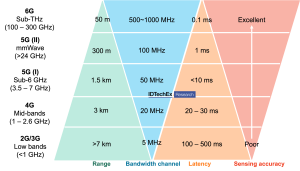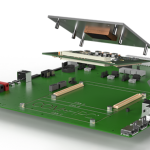5G is already a common feature of modern smartphones, so much so it may appear as an old technology now. However, 5G encompasses several frequency bands some of which have not been used yet.
Whilst much of the 5G infrastructure is a moderate upgrade on existing 4G technology, there is still plenty of scope for higher frequency deployment such as mmWave devices and small cells. Each of these new developments presents its own technological evolution and thermal challenges.
mmWave 5G: Densification of electronics leads to thermal challenges
5G can be categorised into several frequency bands with several of them being repurposed at the existing lower frequencies and some of the new bands reaching 6GHz; see Figure 1. This is where most of the deployment has occurred so far. But, when industry pundits tout 5G’s the huge potential download rates and minimal latency times, they are usually referring to mmWave (> 20GHz). Here, there is still space for significant technological innovation and new applications.

Figure 1: 5G deployment consists of two new bands and existing low frequency bands
Given antenna spacing is equal to half the signal’s wavelength, higher frequency means the antenna can be a lot more compact, with thousands of elements combined into a package a fraction of the size of previous antennas. This however leads to a densification of IC distribution, especially as the ICs sitting directly on the back of the antenna board. In turn this leads to greater heat dissipation and thermal management problems.
IDTechEx research has found that whilst most thermal interface materials (TIMs) used today are below 4W/mK thermal conductivity, the demands of future 5G devices could push this value into the 5-10W/mK range.
More antennas are required
Another key challenge with higher-frequency telecommunication infrastructure is signal propagation. As frequency increases, the signal is more easily attenuated, with broadcast range significantly reduced and the signal easily blocked by walls and windows. One solution to this problem is to use beamforming to directly “target” user devices, allowing greater signal control.
However, this only goes so far. To reach a satisfactory coverage over significant areas, many more of these antennas are required. IDTechEx is predicting a 41-fold increase in the yearly deployments of mmWave antenna by 2032 compared to 2022; see Figure 2. This is not as much of a problem as it appears at first, because, as mentioned earlier, the antennas are very small, allowing their wider use, more easily and in more integrated formats (say, on lampposts), compared to any other previous infrastructure.
Thanks to the requirement for more mmWave antennas, the markets for thermal materials within them are expected to see a five-fold growth in the next five years alone.

Figure 2: mmWave antenna present the greatest TIM market by 2032
Latest report on thermal management
IDTechEx’s latest report on “Thermal Management for 5G” addresses the trends in 5G deployment and how this impacts antenna design, choice of semiconductor technology, die attach materials and thermal interface materials. Both technological aspects and market forecasts are included for the next ten years. Additionally, the report considers many smartphones and how the incorporation of 5G is impacting thermal materials – interface and heat spreaders.
By Dr James Edmondson, Senior Technology Analyst, IDTechEx










